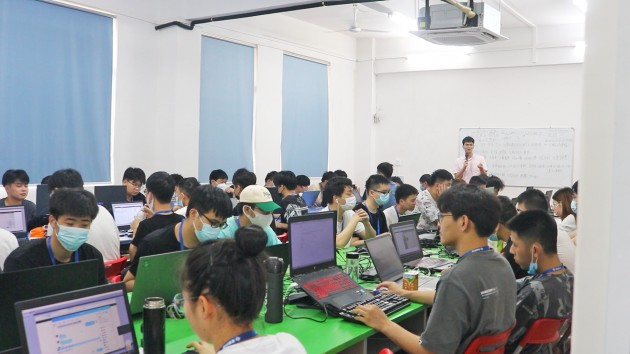Most of our fresh graduates majoring in embedded IT from non-prestigious universities will naturally be anxious because of their weak practical experience in business projects, the inability to interview with good companies, and their unwillingness to choose employment casually. If you want to improve your technical ability by participating in the training of Embedded Technology, can you get a high salary for embedded technology training?
Why can we cultivate a large number of excellent IT talents?
As an innovative IT training institution, Guangji Technology focuses on embedded development courses and practical training, and cultivates high-end talents in intelligent terminal design and development. Through the technical research of business projects and the systematic training of workplace rules, we help students comprehensively improve their technical and workplace abilities to cope with various problems encountered in the interview and work process.

In view of the many problems faced by fresh graduates, Guangji Technology allows students to be "one step ahead" in terms of comprehensive ability through a scientific course teaching system in terms of practical project experience, use of various tools, project management methods, resume making, workplace ability, workplace rules, etc.
Practical projects that are closer to the needs of high salaries
Take a look at the broad syllabus
Phase 1: Embedded Development Fundamentals
This stage of the course helps development engineers to quickly understand the basic elements of embedded development, proficient in the use of Linux operating system, proficient in embedded C language programming methods, have a certain understanding of data structures and software algorithms, and be proficient in the use of an embedded development platform and the construction of development environment, so as to lay a good foundation for further learning embedded Internet of Things application development.
Phase 2: Embedded Linux application development
In order to make the embedded devices operate more efficiently, it is necessary to master the core system programming skills in the embedded operating system, including: multi-process programming, process management, inter-process communication mechanism, multi-threaded programming, inter-thread synchronization and mutex mechanism, thread pool mechanism, etc. Computer networks are widely used in the development of embedded Linux system applications, and network communication technology is required in the field of Internet of Things or industrial Internet.
Stage 3: Advanced programming of embedded software
This stage of the course adopts the idea of C++ object-oriented programming, and develops and designs technologies such as Linux network programming, Linux serial port programming, audio and video programming, and embedded database programming. Familiarity with GUI system programming is an important part of improving the user experience of embedded systems. In the learning process, real-world cases will be introduced, and a lot of practical skills and development experience will be imparted. After completing this course, students will have the ability to develop and apply mainstream embedded graphics systems.
Phase 4: Cortex-M4 application development
Cortex-M4 is an MCU core developed by ARM for embedded microcontroller applications, which has the great advantages of low cost and high performance, and has replaced 51 single-chip microcomputers in many fields and has become the mainstream control chip in the field of embedded microcontroller applications. This session will introduce and combine STMicroelectronics' STM32F429 microcontrollers and FreeRTOS embedded operating systems, enabling engineers to quickly move on to project development in smart home, industrial control, quadcopters, smart wearables, automotive electronics, and more.
Phase 5: Embedded Linux system porting and driver development
This stage of the course enables engineers to have an in-depth understanding of the system framework of the embedded Linux system platform, be familiar with the hardware design principles of the ARM platform, understand the u-boot workflow, Linux kernel configuration and tailoring, and rootfs working principle. Linux device driver is the bridge between the embedded Linux operating system and the embedded hardware platform, without the device driver, the application is in the air, the embedded Linux device driver development course in-depth explanation of the Linux system control hardware methods and frameworks in the embedded platform. It enables engineers to have an in-depth understanding of the architecture of the Linux system kernel, and to be proficient in designing Linux device drivers, and to master the ideas and methods of Linux device driver transplantation.

Stage 6: Python AI development
Python, big data, and artificial intelligence are the hottest topics today. With the popularity of AlphaGo, the topic of machine learning, such as making machines more intelligent, has become very popular in recent years. There is a strong demand for development talents such as big data storage, big data analysis, artificial intelligence, and intelligent identification. This stage of the course mainly introduces the basic knowledge of Python and implements face recognition projects on GEC3399 platforms.
Stage 7: Career Guidance Class
The eighth stage: the practice of the comprehensive project of maker incubation
Scenario-based teaching courseware that meets the needs of enterprise employment
The Guangji technology course platform has a wealth of courseware resources, including more than 4,600 video courseware and more than 2,600 question banks. The courseware can be applied to students of different foundations, providing assistance for students at all stages of learning and practical training.
In terms of the update and iteration of embedded courseware, it is also in line with the mainstream commercial scenarios in the market and closely follows the talent demand direction of major technology manufacturers.
Thousands of household enterprises are accurately docked and transported
In addition to the new model of school-enterprise cooperation, the ecosystem of embedded training has thousands of cooperative enterprises, and students can share the green channel of cooperative enterprises, and at the same time, dozens of special job fairs every year provide massive employment opportunities for Guangji students.
From resume design to written test review plan and interview training, there are employment teachers to guide students throughout the process, so that students can be more smooth in the employment process and reduce being eliminated due to non-technical reasons.
Write at the end
By participating in systematic training, the technical level and professional level of the trainees can be quickly improved, and they will have the opportunity to go ashore smoothly in the competition of high-quality companies and high-quality positions. Through the collaboration of universities, enterprises and professional IT training institutions, we will share high-quality resources, so that excellent people can enter excellent enterprises and achieve high salaries and high-quality employment.
Original title: Can the embedded development training of wide embedded technology get a high salary?
